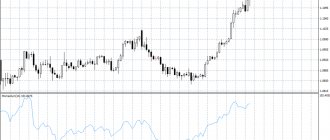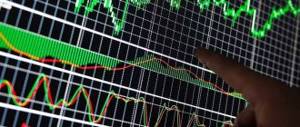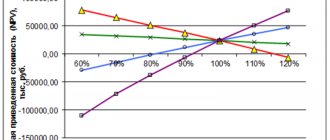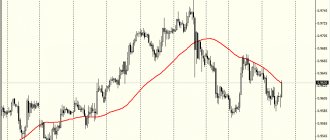ECONOMIC INDICATORS (INDICATORS), values or characteristics showing the state of the economy. Their dynamics are determined by a statistical series of values calculated, usually weekly, monthly or quarterly, which helps to detect trends in economic development and predict its future. Short-term processes and phenomena affecting the state of the economy are very diverse. Some of them recur regularly at certain times of the year, such as the sharp increase in retail sales on New Year's Eve. Other important economic events include strikes and unusual weather conditions, the start and end of wars, a general decline in business activity, and the start of an economic recovery or speculative boom. Since various factors operate from a few weeks to several years, it is very important to have information regularly updated at fairly short intervals.
Basic provisions
The fact that the economic development figures of a number of certain countries are significantly ahead of those of other countries proves the diversity of our world not only in racial, cultural and social terms, but also in macroeconomic terms. The general world picture consists of the development of certain regions and areas, then moving away from generalities to precision, allowing information about specific states, municipalities and cities. The findings are important not only for researchers and government agencies, but also for investors looking for positive investment winds. Considering that for underdeveloped countries the volume of investments received from outside has a life-sustaining value, one can declare a certain whirlpool. Where good financial metrics are generated by the inflow of capital investment, and the inflow of capital is guaranteed by the trend towards good performance. This development of the economic cycle reflects the thesis of the economic situation that rich countries are becoming richer, while poor countries continue to be content with the minimum.
Forecasts.
A person analyzing economic indicators is usually interested not only in determining the level of economic activity in the recent past or present, but also in predicting it for the near future. Consequently, the focus is on indicators that somehow relate to the future. A number of specific leading indicators provide insight into the prospects for specific sectors of the economy or types of economic activity. Currently, for example, leading indicators are published for inflation, the service sector, the metallurgical industry, the financial services market, employment, and exports. In addition, some leading indicators developed for strictly defined purposes may be very useful for other purposes. For example, an inflation indicator allows you to predict interest rates, a stock purchase indicator allows you to track fluctuations in stock prices, and an employment indicator can easily be modified into an unemployment indicator.
One of the uses of leading indicators is short-term forecasts based on preliminary estimates. For example, data from business firms about their planned investment in new machinery and equipment over the next two quarters is collected and analyzed. Another forecast is based on a survey of consumers about their intention to buy a car in the coming year. Another forecast is based on the assumptions of rail freight shippers regarding the number of wagons loaded with a particular product that they will ship in the next quarter (compared to the same quarter last year). Researchers have repeatedly tried to assess the degree of accuracy and objectivity of these forecasts. According to most of them, these forecasts are not highly reliable, but if interpreted correctly, they are sources of useful information. In some cases, discrepancies between forecast and reality may provide clues to future events, as firms tend to correct errors associated with their own misconceptions about the future.
Similar to short-term forecasts based on preliminary estimates, forecasts that use data on commitments to take certain actions in the future. Such data includes information on orders for machinery and equipment, contracts for the construction of plants and factories, budgets or appropriations, the number of buildings under construction, the number of newly established firms and obligations to provide mortgage loans. The movement of indicators of this kind usually outpaces the dynamics of indicators in those areas of activity that they precede, namely indicators of production, employment, sales and expenses.
In addition to those listed, there are other types of indicators that reflect the early stage or beginning of the economic process and, therefore, are also leading. Changes in the length of the workweek due to reductions or increases in overtime, number of shifts, or hours (for part-time workers) usually occur before changes in the number of employees. The prevalence of this sequence of changes makes the average workweek a very useful economic indicator, since its fluctuations precede fluctuations in employment.
Profit indicators have particular analytical value in the process of forecasting future economic development. In an economy based on private enterprise, prospects for profits are a critical determinant of private economic decisions. Equally important is the fear of incurring losses. Profits from past periods can serve as a source of funds for new investments. Therefore, recent earnings or loss data, especially data that reflects likely future earnings trends, deserve close attention. Information on prices, costs and profitability also plays an important role. The same can be said for stock price indices, since the price of a corporation's shares usually reflects the market's assessment of its ability to earn a profit.
Basic indicators
There is a need to identify the definition of the required data, consider the composition of the indicators, provide the main economic indicators, and also master the analysis of indicators of economic security.
So, the main economic indicators are a set of both macroeconomic and more in-depth indicators that characterize the financial and production state of the object of study. Be it a separate state, its regions or a value showing the parameters of regional development. Such data is presented for consideration by the state government and official information bodies of partnership unions created for the integrated development of regions. As well as independent experts and corporations looking for investment opportunities. Or by subjects of the global financial and production community, be it forums or summits. Data published in the form of reports and news have a huge impact on the foreign exchange market, especially on its regional part. Often, regardless of the general mood of reports showing either positive growth dynamics or degrading industry and production schedules. In this case, a big blow comes from the currency of the state, whose economic structure showed negative results over the period of time studied. Often this period is a calendar year. The results for which are published several months after its completion, required for the final collection and processing of data. Since early reports may be incomplete, and therefore cause a commotion on the stock exchange and currencies of national companies. In general, the situation is depicted thanks to two types of indicators: macroeconomic and social indicators. Let's look at them in more detail.
EMPLOYMENT OUTSIDE THE US Agricultural SECTOR
This report is traditionally published within the United States, but it has a huge impact on the dollar exchange rate and, accordingly, is reflected in the entire market. Nonfarm data is published once a month – every first Friday of a new month.
This index displays the number of new jobs created outside the agricultural sector. But what is important for the market is not so much the indicator of new places, but how much the published data will differ from the predicted ones. Most often, the indicators will actually differ, which will provoke a strong jump in volatility. As a result, we can often see fairly strong market movements that form in the shortest possible time.
Economic indicators
As mentioned above, macroeconomic indicators are data on the general system of the economic sphere of the state, characterizing the level of its industry, production, financial sector, employment and food markets and many others. Researchers studying the economic structures of Russia start from indicators of gross domestic product - the total value of goods produced in the country over a certain period of time (often a year). Regardless of the used own or foreign resources. This is a basic indicator of the level of economic security, determining the level of its macroeconomics in both the manufacturing and service sectors. Often in comparison, preference is given not to the indicator as such, but to the dynamics of its change relative to previous periods. This makes GDP one of the most used expressions for comparing the economic situation between periods, where, for example, economic indicators of Russia in the 1990s and 2000s are studied, or for comparing the development of regions for other time cycles.
Latitude, sensitivity and frequency.
As already noted, some elements or aspects of business activity are more sensitive, e.g. subject to fluctuations than others. It is highly desirable to identify sensitive indicators that are broad enough in scope, but not so broad that they become insensitive. However, breadth of coverage and sensitivity are not the only requirements for an economic indicator. The frequency of calculation of indicator values is also of great importance, i.e. information update frequency.
It is also very important to be able to find indicators that are particularly sensitive to precisely the type of fluctuations that are of greatest interest to the user. For example, fluctuations in agricultural production usually do not correlate with indicators of the overall economy, since harvests are often dependent on weather conditions. To neutralize this type of sensitivity, indicators such as production or non-agricultural price indices are used.
Inflation and its meaning
Another key factor is the inflation rate.
Inflation is an extremely dangerous situation for the level of economic security of Russia, meaning an excess of the money supply over the commodity turnover in demand. In simple terms, inflation means a situation in which the amount of money exceeds the recommended norms, which leads to its depreciation. Inflation is regulated not only by the market, but also by the state bank and is one of the most important economic indicators in Russia. Since in the conditions of the ruble crisis, it is the regulation by the national bank that must keep the currency in adequate conditions. The method for detecting inflation is called the consumer price index, which represents the cost of money paid for a basket of goods. These indices of economic movements are also often used for situational comparisons. So, for example, the figures for the economic situation in Russia, for example, the GDP growth index for 2015 showed a decrease of 0.5%, while for 2021 the same figure amounted to 2.5% growth, which indicates an increase in the industrial power of the state.
Where are macroeconomic indexes published?
All macroeconomic indices can be found in economic calendars published by brokers. There are no particular differences between these calendars, so their choice is a matter of trader’s taste.
When studying such a calendar, it is important to pay attention to the difference between the actual and predicted indicator. The more different these data are, the more the news can affect the currency quote.
If you trade using fundamental analysis, we also recommend that you familiarize yourself with what Cot reports are and what they are for.
Gold and foreign exchange reserve
Gold and foreign exchange reserves are another piece of information that tells the researcher about the total amount of both national and foreign currencies in the national bank. And also the presence of money owned by the state in the economies of other countries. This is the main and most direct indicator of the material wealth of an individual state. Indicators of sustainable development must confirm that the country’s economic indicators and its assets are backed by a money supply that exceeds the amount of money “in the hands” of users. That is, citizens, and also ensure the continuation of import supplies for at least 3 months. Compliance with such criteria indicates sufficient material well-being of the country, and also contributes to the regulation of exchange rates and bank rates on both loans and deposits.
Seasonal adjustments.
When analyzing these and some other indicators, it is almost always desirable to isolate regular seasonal fluctuations in values from other fluctuations. This operation is performed by calculating the values of annual seasonal fluctuations based on data from previous years and then making amendments to the current values or subtracting from them. Many indicators are published seasonally adjusted, while others are published without such adjustment. One of the advantages of accounting for adjustments is that it allows you to compare current values not only with the values of the corresponding month of the previous year, but also with the values of the previous or any other month. Unseasonally adjusted data are usually compared with last year's data for the same month. However, in cases where there is a need to quickly and accurately identify a new trend in the economy, comparisons of data over periods of time shorter than a year become especially important. Therefore, it is necessary to use seasonally adjusted data.
Government debts
Public debt, or indicators of public debt - data on the total amount of debt of the state to all individuals and legal entities, foreign companies, partners, suppliers, depositors of government bonds and all others who have the due right to repay the debit debt. When the public debt exceeds the amount of the national budget, the national bank begins to restructure the debt. Most often, by repurchasing the debt through the world market when possessing the necessary foreign exchange funds, or by writing off the debt. Despite its negative status, government debt can often be used as an indicator of economic activity.
Payment balance
The system of economic indicators, criteria and indicators of economic security, indicators of economic growth, as well as indicators of sustainable development are supplemented by such an indicator as the balance of payments. Balance of payments is the ratio of government payments between payments made inside the country from foreign companies to the number of payments made outside the country both by the state itself and its issuers. It represents three sections of the economic situation: the trade balance, the balance of non-commercial payments and services and the level of capital flows, credits and advances.
Occupancy reports
The employment situation is one of the most important indicators of fundamental analysis, which every trader should carefully monitor. Job creation can tell a lot about the overall health of the economy. This is closely linked to future consumer spending, and for the US economy, consumer spending makes up the largest share of GDP at about 70%. The employment report is also a leading economic indicator and can tell a lot about future economic growth.
The U.S. Bureau of Labor Statistics releases the employment report on the first Friday of each month at 8:30 a.m. Eastern Time. Most professional and institutional traders take into account the release of this report, as it is usually the most volatile market event.
The U.S. Employment Report includes a number of labor indicators that are released simultaneously: nonfarm payroll data, average hourly earnings, and the unemployment rate. The impact of the growing number of non-farm jobs can easily be reversed if average hourly earnings fall short of expectations.
A fall in the unemployment rate is usually accompanied by increased pressure to increase wages as fewer people are available to meet the demand of companies and hiring managers.
Unemployment
Important indicators of a country's economic security are unemployment indicators, which is quite understandable, because the fewer workers there are in a country, the less its production capabilities are used. Add to this the fact that the state pays unemployment benefits and you get a state where, due to the lack of production, there is an imbalance in the direction of a decrease in money in the budget for benefits payments. Unemployment is calculated using a mathematical problem, where the conditions are data on the total number of able-bodied citizens correlated with the total number of jobs. Negative results characterize the high level of unemployment, which is also observed in countries with a high outflow of the population for work, or with a high percentage of student youth.
Content
- 1 History of the creation of leading indicators LEI
- 2 Publication format and timing of LEI data
- 3 Features of using indicators in Forex and the stock market
This is an international corporation consisting of more than 500 scientific non-profit organizations from 60 countries, the founder of which was the NICB, the national union of industrialists in the United States, founded in 1916.
The association has been conducting scientific activities and economic research since the mid-20th century, which gained fame and recognition in 1967, first in the United States, after the release of consumer confidence indices.
Important indicators of economic growth
Economic performance data and socio-economic development registers are complemented by leading, lagging and coincident gauges. Leading indicators are data correlated among 11 groups that form the index:
- Number of working hours and workers spent on production;
- New orders received by the manufacturer;
- Average weekly amount for initial claims for insurance benefits;
- Efficient delivery of products to wholesale points;
- Number of agreements for the supply of production equipment;
- Index of permits received for the construction of new housing;
- Amounts of ordered inventory;
- Price elasticity in the market;
- Stock price index;
- Real money supply;
- Dynamics of the volume of outstanding loans among both consumer and legal entities.
Lagging figures characterize a complex index of 7 positions that determines:
- Average duration of unemployment
- Ratio of inventories to sales volumes of goods
- Labor costs per unit of production
- Average parameters of the base rate
- Outstanding loans to commercial and industrial enterprises
- Ratio of consumer credit to personal income
- Graph of movement of consumer prices for goods and services
These are key economic registers that reflect the overall level of the country's production economy and its efficiency, which can also be used as indicators of the economic security of the region, indicators of the economic security of the enterprise, indicators of sustainable development and a short-term economic indicator. Also, the measure of the economic security of an enterprise can be supplemented by the total amount of purchased raw materials and sold products.
No list of key metrics would be complete without mentioning something called security thresholds. These are values that reflect the minimum acceptable standards, beyond which, as a rule, a destructive collapse occurs, depending on the scale, which can develop into a crisis. Threshold values of indicators of trade and industrial security have different specifics for studying sectors of government activity or the situation directly in a particular regional territory. We also must not forget that the values of economic security indicators are not always basic, that is, established. They can often vary depending on seasonality and the general global situation.
Gross domestic product.
Also on topic:
WORLD ECONOMY
After seasonal adjustments are made, the components of economic aggregates are typically analyzed. For example, GDP may initially be divided into three components: domestic sales to final consumers, net exports, and changes in inventories. Isolating such a component as changes in inventories is of great importance, since it is fluctuations in the accumulation of these inventories that often explain most or even all short-term changes in production volumes. In addition, the factors that determine the accumulation of inventories are not the same as those that cause fluctuations in sales to final consumers. The increase or decrease in the accumulation of these inventories often outpaces the increase or decrease in final sales by one or two quarters. Further, sales to final consumers can be divided into sales to households, business firms (machinery and equipment), government and foreign buyers. The movements of these several components also often do not coincide and are determined by various factors.
Salary
This implies the level of wages for the population, as well as the ratio of this indicator to the regional average. Information flows can be provided in both hourly and monthly payment formats. Metrics that calculate the annual income of citizens when employed are common. Can be used in conjunction with unemployment data to identify social gaps and classify society.
Healthcare
Broad data coverage of these figures may include information on the number of medical institutions, and in quantitative terms relative to the total number of souls, the number of pharmacies per capita, the total number of services provided, participants in health insurance programs, disease epidemics, the number of registered infections of one or another virus, manufactured and imported medicinal products, average age of life and the general level of the population regularly seeking medical care
Spreading.
Monitoring the dynamics of individual components of aggregate indicators is very useful for another reason. Business cycle studies show that deep economic downturns and strong recoveries affect a wider range of industries and businesses than relatively mild downturns and recoveries. It follows that the scope of fluctuations - for example, measured by the number of companies whose profits rose relative to the number of companies whose profits fell - is a significant indicator of the magnitude of cyclical fluctuations. In addition, it has been established that the contraction in the scope of business growth usually begins 6-12 months before the growth of aggregate indicators stops. Likewise, the scope of decline in business activity tends to narrow some time before the decline in activity ceases. Consequently, the narrowing of the range of fluctuations or trends can be considered a phenomenon that requires close monitoring when using economic indicators to track downturns and recoveries in the economy.
Education
It often manifests itself in data on the number of educational institutions of both entry-level and secondary and higher education, the total percentage of the population who have received one or another academic status, who have graduated from school or university, the percentage of those admitted to master’s programs, those employed in teaching, data on those employed in their specialty, the ratio and the overall level of success of paid and state educational programs, the success of students in certain disciplines, the number of seminars and festivals of educational significance held, the number of people traveling abroad for educational purposes or entering the state.
Indicators of the standard of living of the population are supplemented by cultural data. Culture in this case represents the number of events held, as well as the number of people who attended them, which can be expressed either as a specific number or as a percentage of the total population. Based on this percentage, figures for reading books and watching educational and documentary films are also derived. Thanks to opinion polls, it becomes possible to obtain data on the level of knowledge of etiquette rules among citizens and residents of the region and many other data.
Strategy.
The abundance of macroeconomic indicators does not allow us to create one strategy that is correct for all times. However, there are rules, knowledge of which ensures increased profits:
- Buy on rumors. It is best to buy currency when there are rumors about the release of this or that news.
- Sell with facts. You should get rid of the purchased currency at the moment when relevant facts appear that indicate a continuation of the trend of falling value.
Data on macroeconomic indicators are published in leading financial journals and are available on the Internet on the official websites of government agencies and private organizations.
Key macroeconomic indicators are suitable for fundamental analysis.
A good trader pays attention to other factors, which include the balance of trade, the ratio of exports to imports, the geopolitical situation and the like. In fact, it becomes mandatory to watch the news to have an idea of what is happening.
Trading on macroeconomic indicators is ideally complemented by the use of specialized tools in indicators. A combination of several methods is a condition for achieving success.
Read analysts before and after making a deal. Compare information. Look for optimal strategies and earn money.










